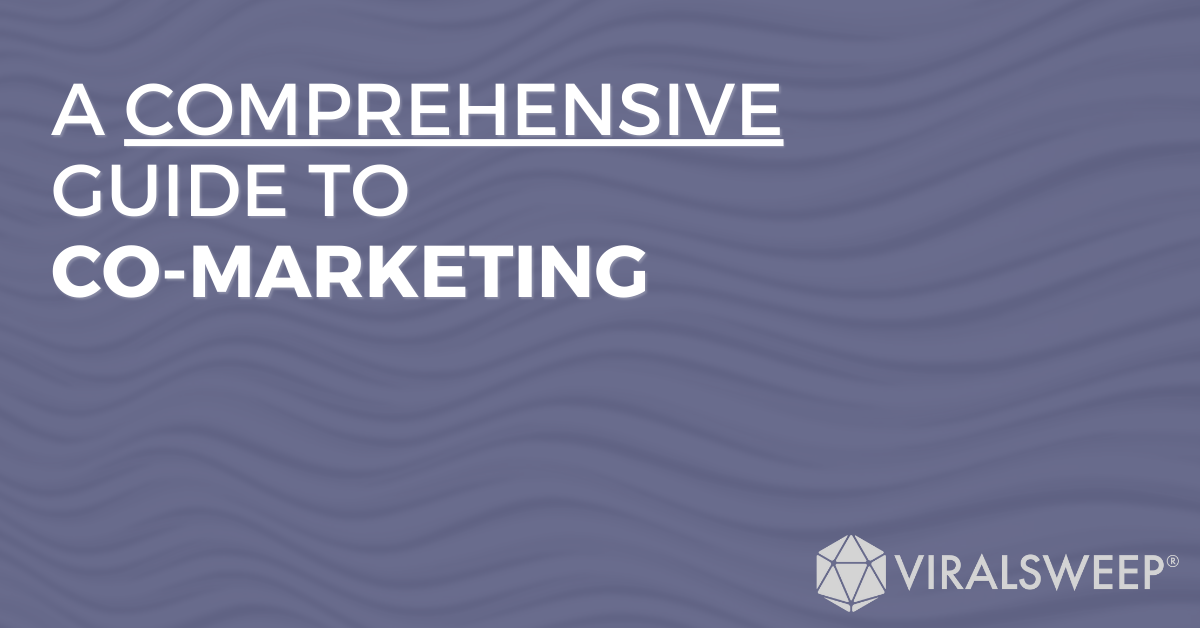Marketing efforts can be a rather tricky endeavor, no matter what your budget is. The competitive nature of attention means that with an often over-saturated media environment, it is difficult for any single organization to stand out above the rest.
This post will provide a clear overview of one method to cut through the marketing knot: co-marketing.
Co-marketing is quickly becoming the gold standard of marketing techniques that can be leveraged to expand organizations’ reach through brand partnerships massively.
In addition to providing an overview of the method, this post also delves into the history of co-marketing to outline key lessons for successful campaigns that you can leverage for your own campaigns.
What Is Co-Marketing?
In short, co-marketing refers to leveraging the power of partnering and working with other similarly-aligned organizations to boost each other’s reach while dividing the costs for everyone.
Co-marketing creates a mutually beneficial relationship that enables both partners to access new markets, new audiences, and new customers and boost sales in the process.
There are, however, a few key differences in the types of co-marketing you should know about.
Types of Co-Marketing
1. Cross-Promotion – This technique is where two companies exchange promotional materials such as ads, coupons, and exposure to each other’s customers to help increase each other’s visibility.
For example, a toy store partners with a local clothing store to offer discounts on both products with purchase at either partner’s location.
2. Joint Ventures – This type of co-marketing involves both firms creating a new product or service together from start to finish, such as an apparel company producing exclusive capsule collections with another brand.
3. Content Creation & Distribution – Partners collaborate to create content. For example, a fitness brand might partner with a health blog to produce an e-book together filled with nutrition tips and exercise advice while promoting both companies’ products and services.
4. Affiliate Marketing – This marketing involves one company paying another to promote its products or services via special links that track sales referrals.
An example would be an athleisure brand teaming up with a YouTube fitness influencer who will promote their brand products, e.g., their workout clothes, in exchange for a commission.
No matter which type of co-marketing, it is an incredibly effective way to increase reach, boost sales, and expand an organization’s customer base.
Co-Promotion vs. Co-Marketing
Not to be confused with cross-promotion discussed above, the term “co-promotion” is often used interchangeably with co-marketing. However, there are a few important distinctions that make a significant difference.
Where co-marketing has each partner promoting their own products using a shared strategy like the ones mentioned above, co-promotion has partners join forces together to promote a singular product with the same message.
For example, Chipotle and DoorDash’s summer 2018 collaboration rewarded customers with special discounts and prizes on delivery orders placed on the DoorDash app.
Customers received free delivery on orders over $10 and a chance to win Chipotle catering for up to 250 people.
This collaboration is considered a co-promotion because both parties are promoting the same product (i.e., restaurant delivery) with the same message (book through us for a discount and chance to win a great prize).
When YouTube music artist Kina Grannis partnered with Google Chrome for her album launch in 2014, it was considered co-marketing.
Their campaign was centered around an interactive online video that allowed viewers to interact with the music as it played. This collaboration resulted in over 7 million views of the video in just three days on the Google-owned platform and a significant bump in digital sales for Kina Grannis’s first full-length album.
Both co-promotion and co-marketing have their advantages, but as you’ll see, there’s a reason the latter is so popular.
Benefits of Co-Marketing
With co-marketing, businesses gain from increased exposure for their open distinct brand identity while still saving on digital marketing costs, garnering joint credibility with the partner company, and higher engagement with customers.
Let’s take a look at each of these benefits more specifically.
Increased Reach and Brand Exposure
Co-marketing helps expose both brands to each other’s customer base and visitors. This expanded reach can increase quality traffic and sales for both parties.
However, unlike co-promotion, co-marketing retains a clear brand identity for each partner, making it a simple win-win situation for everyone involved.
Cost Savings
Instead of spending a significant portion of the budget on ad placement, a partnership with an established site/company can provide a better return on investment (ROI). It’s much more cost effective.
This approach can free up funds for other marketing efforts or other needs of the company.
Joint Credibility
People like it when two companies work together because if they already trust one brand, they tend to feel more comfortable trusting the new brand if the old one is recommending them.
Increased Engagement
It can help make people more interested in a brand and boost brand awareness by encouraging them to learn more or buy products.
If they see the two companies working together, consumers may also become loyal to the brand. This strategy helps them become better known and liked by customers.
Case Studies of Successful Co-marketing Campaigns
Looking at case studies of successful online promotions can help provide valuable insights. Here are three examples of companies that have had mutually beneficial collaborations:
1. Apple and Nike created a promotion for a special edition Nike+ running shoe with integrated sensors that connected to the Nike+ app.
By combining their resources, these two brands created an innovative product that tracked performance data for runners. The campaign was able to reach more people than either company would have been able to do on its own.
2. AT&T and Spotify collaborated to provide AT&T customers with free access to Spotify Premium, which has features like ad-free listening, unlimited skips, and offline listening.
It was mutually beneficial as it increased customer loyalty while also driving sales of subscription services.
3. Amazon and Marriott International leveraged both brands’ strengths to create an exclusive promotion that rewarded customers with Amazon gift cards when they stayed at select Marriott hotels.
Through this campaign, Marriott was able to attract new customers and increase bookings, while Amazon was able to drive sales on its website.
The success of these campaigns can be attributed to brand power, the effective use of exclusive benefits, and the clear alignment of brand messaging and values.
By understanding each other’s audiences, they created content that resonated with their respective target markets and drove results for both partners.
Based on these examples, let’s extrapolate a few general principles and pro tips for a stellar co-marketing campaign and co-marketing activities.
Best Practices for a Successful Co-marketing Strategy
Open and Honest Communication
When working together with another company on a co-marketing campaign, it’s important to have open and honest communication. Failure to communicate clearly can hurt the success of the campaign more than other projects because of a lack of familiarity with the practices of a different organization.
Here are nine tips for achieving and maintaining good communication throughout the campaign.
1. Establish communication protocols and methods in advance.
2. Set clear expectations and goals for the partnership.
3. Listen to each other’s ideas, suggestions, and concerns.
4. Document all agreements made between partners.
5. Respect deadlines and commitments agreed upon by both parties.
6. Share resources to maximize the success of the campaign.
7. Provide regular feedback during the course of the project.
8. Find ways to show appreciation for your partner’s efforts.
9. Remain flexible enough to adjust when plans or circumstances change.
Align Brand Messaging and Values
It’s important that partners have the same message and goals. If their messages do not match up, it can confuse people and make them not trust either company.
To ensure this mistrust doesn’t happen, partners must communicate and set expectations and goals before the campaign starts. They have to ensure that everyone agrees on the message they want to send out so that everyone has the same goal in mind when working on the project.
Select the Right Partner
It’s vital to choose a partner that shares compatible messaging, values, and marketing goals. When selecting a partner, it’s important to consider criteria such as brand compatibility, target audience, and marketing goals.
Brand compatibility refers to how well two brands are positioned to work together. It’s the same as saying they’re a good fit for the campaign if they are compatible.
The partnership should make sense from an external perspective and reinforce the message of both companies.
It should also fit their core values and ethics; customers should not feel like either company’s image or reputation is being compromised by the partnership.
Target audience is another key factor when considering potential partners. Companies should evaluate which audiences they want to reach through the campaign and if those audiences overlap with their partner’s customer base.
Having knowledge of each other’s customer demographics can help create content that resonates with both companies’ target audiences.
Lastly, it’s essential to have shared marketing goals. Potential partners need to define success for them in terms of visibility, sales, ROI, or whatever metric they deem fit before entering into any partnership agreements.
This approach ensures that everyone involved knows what objectives they need to achieve and how each party will benefit from the collaboration.
Offer Exclusive Benefits to Customers
This strategy can make a co-marketing campaign successful. It’s like giving customers special treats! Some types of exclusive benefits are discounts, free trials, and limited-time offers that they can’t get anywhere else.
This approach is a great way to encourage people to take action and build loyalty with both brands. When customers see that they get something special no one else has access to, it can create a sense of excitement and urgency that could lead to more engagement and sales.
You can use social media to generate more hype around your offers.
Continuously Monitor and Refine the Campaign
This step is vital for measuring success. Different metrics like reach, engagement, and conversion rate can be early indicators that you need to make changes.
- Reach is how many people know about the campaign.
- Engagement is how much they are interested in it and what they do with it.
- The conversion rate is how many people did something with the campaign, like making a purchase or signing up for an event.
It’s important to review the data and make adjustments as needed. This process ensures that the campaign is aligned with your goals and maximizes its success.
Adjustments may need to be made to content, messaging, or timing, depending on the current data. It’s also important to track competitors’ campaigns and stay ahead of trends to remain competitive.
Launch a Successful Co-marketing Campaign with ViralSweep
Co-marketing and co-promotion are both mutually beneficial partnerships, but as this article has shown, it takes skill to hold to the best practices and keep campaigns running smoothly.
To lock in the benefits of these new marketing strategies, companies like ViralSweep exist to set up and execute campaigns for you while tracking their results to provide your organization with cutting-edge analytics to do it even better next time.
Working with ViralSweep is easy:
Once brands have identified potential partners and worked out the terms of the campaign together, such as who is contributing what resources like time and funds, they can create a ViralSweep campaign to handle the rest.
They can customize their campaign with logos and branding from both partners easily and efficiently to keep the momentum going.
With ViralSweep’s analytics tools, it’s easy to track key metrics like reach, engagement, and conversion rates for each partner. This data will help brands understand how effective the co-promotion is and enable adjustments to be made accordingly.
Brands can also use these insights to measure success over time or compare performance against other campaigns.
When it comes to successful co-marketing, ViralSweep has had several great partnerships.
One of the most prominent is the collaboration with EVELO, an electric bike company.
In June 2015, they partnered with ViralSweep for a Father’s Day Giveaway that generated almost $40,000 in sales in just 12 days. When you compare that with the $2,419 investment EVELO spent on this campaign, the ROI is inarguably impressive.
The Bruce Lee Family Company gave away an extremely rare pair of Nike Kyrie 3 “Mamba Mentality” Sneakers via exclusive sweepstakes with ViralSweep.
The campaign resulted in over 20,000 new Bruce Lee insiders and increased engagement via comments, retweets, and new followers.
If you’re looking to run successful co-promotion or co-marketing campaigns that drive results, ViralSweep is the perfect solution.
Get started with ViralSweep today, and see what a difference an effective marketing strategy can make!





















